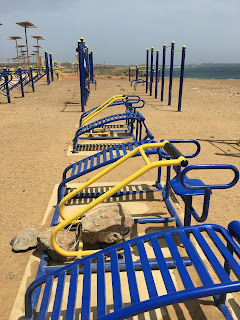Thursday, April 20, 2017
Nanga def? How are you?
Magifique. I am well.
No tudu? What's your name?
Man gee tu du. My name is...
Dieureudief (sounds like jerejef) Thank you
I am fairly certain that I misspelled everything above! But this it how it sounds to my ear. The Senegalese have a rich culture but what stands out the most is "teranga" which means hospitality. The people greet each other in several ways and instead of simply saying hello, there is an exchange in Wolof, the main African language spoken, followed by their French greetings (which is the national language) followed by, for many, English greetings! It can go on for several minutes.
Senegal is the most western country on the African continent. People here can be traced back to the Paleolithic period. Before European settlers, there was a history of Saharan empires. In the 15th century, the Portuguese merchants came to set up trading for gold and slaves. By the 17th century, the French came and colonized it. The first colony was Saint Louis in 1659.
Senegal became an independent nation on April 4, 1960. The lion and the baobab tree are the national symbols. There was no violence for their independence. There have been 4 presidents since then. Leopold Senghor was the first. He was a writer and a veteran of WWII. He held office from 1960-1981 and left office by choice. Mackey Sall is the current president since 2012. Now there is a 2 term limit with each term being 5 years.
There are 36 ethnic groups in the country but the main ones are Wolof, Pulaar, Serere and Mandingo. The country is 94% Muslim, 5% Christian and 1% other and they respect all of the holidays and often celebrate together. They are out of school for all of them too!
The national sport is wrestling and the main winner has the title of king. The traditional clothes are dyed fabric and they are beautiful and colorful. There are many instruments but I have only heard the drums so far.
There is so much to this beautiful culture--this is just a brief glimpse.



























